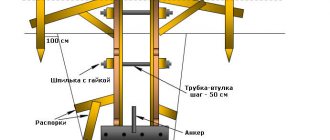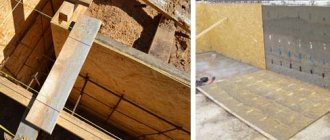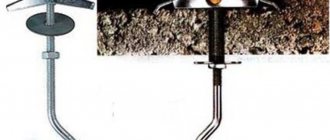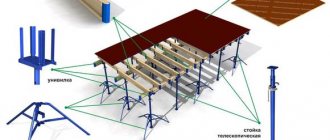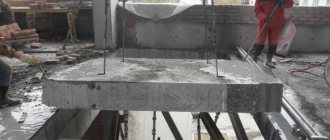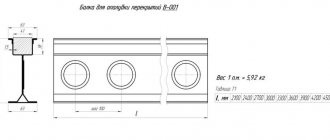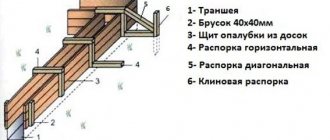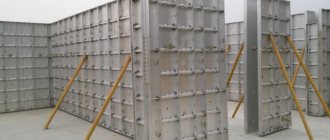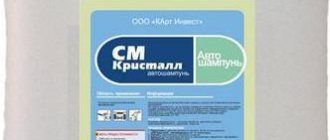In modern construction, monolithic technologies are often used. The peculiarity of this method is that the structures are cast from concrete mortar, and are not assembled from blocks or bricks.
To pour the concrete solution, special forms are assembled from panels. To connect them, rods are used, which are inserted into the mounting holes on the boards. To fasten these stubbles, a special formwork clamp is used; its main purpose is to securely fix the elements.
What are clamps for?
When installing formwork forms, panels made of metal, plastic or laminated plywood are installed opposite each other. If previously coupling bolts with nuts were used to fasten panels together, nowadays spring clamps are increasingly used in construction.
These are fairly simple devices that can withstand the loads exerted by the concrete mixture. Clamps are used in the construction of formwork for casting foundations and walls. The design of the lock is simple, it consists of the following parts:
- metal platforms (standard size 105 by 70 mm), these platforms, reinforced with a stiffener, have holes for reinforcing rods;
- a guide that is welded to the platform at a right angle;
- a powerful spring and a movable tongue with teeth, these parts are secured with strong rivets.
The tongue hooks onto the reinforcing bars, which are inserted into the mounting holes of the formwork panels, so this part must be as strong and resistant to loads as possible. The part is made from durable metal with an anti-corrosion coating.
The use of spring locks is possible when using reinforcing bars with a diameter of 6 to 20 mm. To secure the clamp, you must use a special key with which the spring is tightened. Let's figure out what the advantages of using clamps are, what types of these devices exist and what differences exist between them.
Types and design of spring clamps for formwork
Until recently, the traditional kit for fixing formwork panels was a tie bolt, two fixing nuts and consumables (cones and PVC pipe). Nowadays, for these purposes, builders are increasingly using a spring clamp for formwork. The loads that such clamps can withstand are quite suitable for arranging the formwork of foundations, columns and walls of monolithic houses.
Spring clamp design
Structurally, the spring clamp is quite simple. It consists of:
- a metal platform (standard size 70⨯105 mm) with stiffening ribs and a hole (Ø=10 mm) for a reinforcing bar;
- a guide body welded to the platform at an angle of 90˚;
- a movable toothed tongue and a powerful spring, secured to the body with two strong rivets.
A rigid and elastic spring ensures that the toothed tongue engages the reinforcement (Ø=6÷10 mm; smooth or ribbed). Professionals consider the most optimal use of ribbed reinforcement Ø=8 mm. The tongue, which is the most important structural unit, is responsible for maximum loads and long service life.
The material of this element is hardened in a special way, then an anti-corrosion coating is applied to it (most often galvanized).
As a rule, reinforcing bars are made from steel grades with a low carbon content, so the hardened teeth of the tongue easily engage the reinforcement and tightly fix the product to the bar after tightening with a clamping wrench.
Types of clamps
Depending on the load that spring formwork clamps can withstand, they are divided into:
- simple (standard), withstanding loads of 2÷2.5 tons;
- reinforced (designed for loads of 3÷4 tons).
For the manufacture of platforms for standard products, steel with a thickness of 3.5 mm is used; for reinforced ones – 4 mm. The main difference between the reinforced version and a simple lock is an additional stiffening rib welded to the body and platform.
This design prevents the platform from deforming under heavy loads. The design and material of the tongue are the same for both varieties (the standard metal thickness for the tongue is 6.1 mm).
Advantages and disadvantages of clamps
To understand which fastening option to choose when installing formwork, it is necessary to evaluate the advantages and disadvantages of spring clamps and compare them with the use of tie bolts. The main advantages of the application are:
- Save time. Installing and removing a spring lock is much easier and faster than a bolt, since you do not need to waste time tightening and unscrewing the nuts;
- Rational distribution of funds. Clamps are less expensive than a set of pinch bolts.
- High strength. The use of spring locks allows you to create a strong and reliable fastening.
- High turnover. Spring locks withstand numerous operating cycles.
- Ease of installation. Install spring clips only on one side of the formwork. A retainer is welded on the second side of the rod - a piece of reinforcement. Thus, one end of the rod will look like the letter “T”, and the other will remain free. The free end is inserted into the mounting holes and a spring clip is installed on it.
- Saving materials. When installing tie bolts, they are mounted in PVC tubes to prevent contact of the fasteners with the concrete mixture. As a result, holes remain in the monolithic structure. When using clamps, there is no need to remove the reinforcing bar; it will be enough to simply cut off the protruding end of the reinforcement.
- Versatility. The use of this fastener is possible when constructing formwork forms of any size.
But, despite the numerous advantages, this fastening method also has a significant drawback, namely the load limitation. Locks can withstand pressure of no more than 4 tons. Therefore, when constructing large structures, this type of fastener is practically not used.
Advice! For comparison, we give an indicator of the maximum load that can be exerted on the coupling bolts; it is 20 tons, that is, 5 times more than the maximum load for a spring lock.
Tie nuts for formwork
RION Group of Companies has been producing fastening components for more than 10 years. The company offers to buy nuts for formwork at a price from the manufacturer. We sell the following types of parts for monolithic construction:
- standard type of fastener. The part is cast from cast iron, which guarantees its durability and strength. For additional anti-corrosion protection, the product is powder coated.
- galvanized tie rod, similar to the previous version. A distinctive feature is the protective treatment method. The product is coated with a zinc compound. This processing method minimizes the negative effects of the environment on the metal. Parts are not susceptible to corrosion caused by exposure to rain.
- waterstop for formwork. A type of fastener for specialized use in hydraulic structures. The installation of the product is designed to prevent water from entering the body of the monolith. The peculiarity of pouring the monolith is that the tension screw connecting the panels of the structure passes through the body of the monolith. As a result, after the concrete hardens, there remains a hole into which liquid can penetrate. It gradually destroys the ceiling and can result in mold and other deformations. Waterstop covers this hole. The clamping screw is screwed into the part from both sides, after which the product is installed between the panels and the concrete mixture is poured into the structure. The screws are removed, and the part itself remains in the concrete.
- combi-plate or hinged, available for fixing screws at an angle. Since this design feature involves the use of fasteners on inclined panels, it must withstand increased loads. According to test data, this type of tie fastener for formwork can withstand a load of 85-240 kN.
All types of coupling nuts from the manufacturer are available in stock in Moscow, at bases in Lyubertsy, Tver and Ryazan. In addition to the nuts themselves, you can purchase a complete set for the tie: screws, washers, king pins.
Types of clamps
Spring clips are produced in different types; classification is carried out taking into account several characteristics. According to the material of manufacture, they are distinguished:
- steel with powder coating;
- steel with galvanization.
Galvanized steel models will last longer. The fact is that powder paint provides worse corrosion protection than galvanizing. In addition, galvanized parts do not require periodic renewal of the outer coating, unlike painted parts. There are 3 types of load:
- lightweight, capable of withstanding loads of up to 2000 kg, their use is possible in the construction of small architectural elements;
- reinforced models can withstand loads of up to 2500 kg, the difference is the material of the tongue; the metal for the manufacture of this part is hardened in a nitrogen environment. In addition, a stronger spring is used;
- super-reinforced, equipped with an additional stiffening rib on the platform, these models can withstand loads of up to 4000 kg.
Manufacturers and prices
Among Russian manufacturers of spring clamps for panel formwork, the company occupies a leading position in the construction market. A simple model (load up to 2500 kg) costs 50–60 rubles. The reinforced Yakbizon version from this manufacturer can withstand maximum loads of up to 3000 kg: the tongue of the product is hardened in a nitrogen environment, which gives it special strength and ensures a long service life. The cost of such a product is 71÷92 rubles.
Of the imported products in this category, clamps (Türkiye) are the most widely represented. The company produces both simple and reinforced devices. The price of products from this manufacturer, depending on the load: 50÷85 rubles per piece.
All manufacturers of spring clamps also produce crimp keys for their installation. The price varies from 1800 to 2500 rubles.
What is a formwork spring clamp?
To reduce the time and cost of installing formwork, today a special device has appeared on the construction market that can fix temporary structures quickly and economically - a formwork clamp. Since the disadvantage of wood panels is their deformation, the ability to swell and shrink, the use of mechanical locks will allow you to fix and maintain the distance between the support plates while pouring concrete.
In monolithic construction, a spring clamp for formwork (clip, “frog” or lock) is mainly used.
Ideal pouring parameters when installing large formwork systems provide for reliable fastening of each monolithic element. In such cases, a spring clamp is used, since it simplifies and speeds up the installation of the fence, making it more stable. “Frogs” eliminate the need for spacer tubes while maintaining the tightness of the panels.
Depending on the steel material, the formwork clip can withstand stress of up to 4.5 tons, but the maximum load should not exceed 2.5 tons. The devices are used for collapsible sheet metal and monolithic building systems. The most effective clamp for small-panel formwork is used for medium-thick concrete masses.
Features and Benefits
“Frogs” are a clip installed on a platform with a special tongue that snaps the fittings into place. The formwork spring clamp is produced in Turkey (Prom, Aldem, Hold), Russia (Chiroz company), China, Germany, Poland.
The spring lock differs in the following categories:
Manufacturing strength affects the ability of spring clips to resist destruction under the influence of external loads. In terms of stability, locks can be reinforced (tensor) or light (ordinary). Structurally, they are no different from each other. However, for different pouring conditions it is necessary to use appropriate subtypes.
Lightweight “frogs” are used for loads of up to 2 tons and have a galvanized toothed tongue; they are manufactured by Prom. Reinforced clips are designed for 2-4 tons, have a nitro-carburized toothed tongue and contain a stiffener that enhances the reliability and stability of the structure. Companies Chiroz, Hold, Aldem produce clamps that can withstand more than 3 tons.
Mechanical clamps are made from low carbon steel. The surface can be galvanized, painted, powder coated or electrostatically sprayed. The Prom spring clamp is made with a galvanized toothed tongue, which avoids its deformation during operation, and Chiroz clips have a hardened ratchet locking mechanism.
The sizes do not differ significantly from each other. The values range from 70 (75) to 105 (110) mm, thickness is 3-4 mm.
The main advantage is:
- installation speed;
- convenience during practical use;
- an alternative to traditional expensive spacers;
- affordable price in contrast to coupling screws and nuts.
